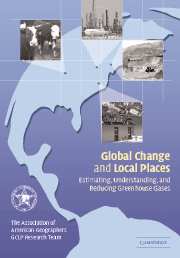Book contents
- Frontmatter
- Contents
- List of contributors
- Foreword
- Preface
- Acknowledgments
- Part One Global change and local places
- Part Two Learning from localities
- 3 Global change and Southwestern Kansas: local emissions and non-local determinants
- 4 Northwestern North Carolina: local diversity in an era of change
- 5 Northwestern Ohio: re-industrialization and emission reduction
- 6 Global change and Central Pennsylvania: local resources and impacts of mitigation
- Part Three Beyond Kyoto I: greenhouse gas reduction in local places
- Part Four Beyond Kyoto II: greenhouse gas reduction potentials and strategies
- Index
- References
6 - Global change and Central Pennsylvania: local resources and impacts of mitigation
Published online by Cambridge University Press: 31 July 2009
- Frontmatter
- Contents
- List of contributors
- Foreword
- Preface
- Acknowledgments
- Part One Global change and local places
- Part Two Learning from localities
- 3 Global change and Southwestern Kansas: local emissions and non-local determinants
- 4 Northwestern North Carolina: local diversity in an era of change
- 5 Northwestern Ohio: re-industrialization and emission reduction
- 6 Global change and Central Pennsylvania: local resources and impacts of mitigation
- Part Three Beyond Kyoto I: greenhouse gas reduction in local places
- Part Four Beyond Kyoto II: greenhouse gas reduction potentials and strategies
- Index
- References
Summary
The Central Pennsylvania study area was incorporated into the Global Change and Local Places project because it provides telling contrasts with the other three study areas. Part of its economy relies heavily on local coal, a potential target for greenhouse gas mitigation strategies, and most of the Central Pennsylvania study area's greenhouse gas emissions originate in local coal resources. If forced to reduce emissions substantially, the area either would have to find ways to reduce sharply the emissions seemingly inherent in coal use, or stop using coal, removing one of the mainstays of the local economy. A second attraction for Global Change and Local Places was that the area has been a focus for research on regional development and climate change by faculty and students at the Pennsylvania State University, and attention to the effects of scale of analysis has been an integral part of that research.
Landscape, life, and livelihood
The five-county study area in the center of Pennsylvania (Figure 2.7) is a complex, sparsely populated amalgam of Appalachia and academia. Its population was 305,000 in 1990. For the study area in its entirely, population growth has been a modest 13% since 1970. The municipality of State College, home to Penn State University, is the largest settlement in the region with a population of 40,000 students and an equal number of permanent residents. The university population's influence is evident in the average age of residents in the respective counties.
- Type
- Chapter
- Information
- Global Change and Local PlacesEstimating, Understanding, and Reducing Greenhouse Gases, pp. 122 - 140Publisher: Cambridge University PressPrint publication year: 2003
References
- 1
- Cited by



